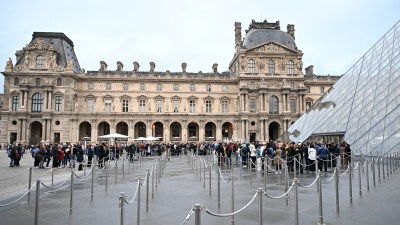We Will Build Millions of Houses
But it will be because of Indian ingenuity,not sarkari rules,which make building small apartments all but unprofitable.
But it will be because of Indian ingenuity,not sarkari rules,which make building small apartments all but unprofitable
It is now pretty widely known in a hackneyed sort of way that large parts of India are not shining in fact they are pretty dark. We can,of course,sit down and weep not by the waters of Leman,but by the waters of the disgusting Mithi,the stinking Cooum or the drain-like Yamuna! Or we can look at this as an opportunity. Which other country has a latent demand for a hundred million new homes? It is pretty much impossible to build and sell new homes in most parts of the world. In fact,their problem seems to be how to get rid of empty and unsold homes.
That is not a problem in India. Build and it will sell. We have so many unshining and un-housed people in our country they who sleep on the sidewalks,under flyovers and in kachcha (what a wonderful word,it translates as unripe) hutments made of sticks,palm leaves,cardboard,corrugated iron and plastic sheets. All of them desperately need and want pucca (you got it,ripe) homes. So whats the problem? Why dont we simply build for them homes like ours? If only business were that simple. Between the idea and the execution,there always falls some shadow. Dont we know that?
The late CK Prahlad taught us that there was a fortune to be made selling products and services and one presumes that he included residences to the poor at the base of the pyramid. But he also taught us that just because they are poor,we should not assume that the sale will be easy. We need to apply the same marketing principles and spend the same amount of nervous energy that we would when we sell to the middle class and the rich. The enormous task of housing the un-housed in India over the next 10 years is not easy,but it is not impossible either.
First,some stunning consumer insights that are now becoming widely known: Indias aspiring classes (those who want to buy and/or move into a pucca home are by definition aspiring) are clear about many things:
* Housing is important,but by no means the most important consumption item. Education for children,especially English medium education,is the first priority.
* Traditional/eco-friendly/local material-based housing is rejected out of hand. Aspiring families want to live in cement-concrete homes just like the ones you and I live in. They associate so called appropriate technologies with poor quality. You may argue but they are unlikely to budge.
* They want indoor toilets. To be more precise,they do not want shared toilets. They know for a fact (not from a reading of theoretical economics) the problem of the commons: assets that belong to all are abused,misused and disfigured. No one maintains common toilets. Besides,common toilets located at a distance from your living space are a security hazard. Women are routinely assaulted on their way to or from these toilets. So if your daughter has diarrhoea,you may have to stay awake all night to accompany her to the common toilet if you want her to be safe!
* They are quite okay with Western-style toilets,which in any case are cheaper to build than Indian-style ones,a fact that many may not know.
* Preferences for floors are interesting. In most parts of the country,consumers prefer ground-floor flats and maybe first- floor ones. Higher floors are at a discount (quite a contrast from the behaviour of the rich!). The consumers know instinctively that given the pathetic nature of Indias electricity supply,elevators are rarely likely to work. In Mumbai,its different though. People are scared of floods and have no faith in municipal storm-water drains. They believe that ground-floor flats will get flooded.
* Consumers want access to private English medium schools. If there is a decent one within walking distance,it would be the icing on the cake.
* Visual privacy is important. Families want two-bed-room dwellings even if the walls are paper thin and the rooms,tiny.
* And they want homes that do not leak. Not an unreasonable proposition,that one.
Now for the supply side problem.
Given the bizarre situation of land titles,land-zoning (the notorious conversion requirements from agricultural to non-agricultural status),the 17 different approvals required before construction can start,the opacity in the system (there are no websites with updated municipal bylaws),we can safely assume that Rs 200-300 extra tax has been paid to the exchequer others paid to influential architects and consultants. Now if you are selling luxury flats at Rs 7,000 a square foot,the Rs 300 extra transaction cost is a rounding-off error. If you are selling at Rs 1,000-1,500 a square foot,the entire profit margin is wiped out. This effectively means that we have a system of laws that makes it impossible to build small flats for aspiring Indians. Our governments,it appears,want builders to build only for the rich. And with costs,factor in delays. It takes six to 12 months to obtain approval from the Ministry of Environmental Affairs (yes,such approvals are needed even for low cost housing projects),let alone myriad other local approvals. No wonder,Indias builders build for the rich. They are only following the wishes of our planners.
All this presents a pretty dismal picture. And yet,as a betting person,I would wager that we will have millions of homes built in the next 10 years for the aspiring citizens of this country. And this will happen because of our ingenuity,not because of the government,until finally when the government might even take credit for something it did its best to stifle. After all,in a country where Karsanbhai Patel created Nirma,where Brij Mohan Munjal created the peoples bicycle,where the Tatas have created the worlds cheapest car,it stands to reason that we will find a way.
But its not going to be easy. Let us not underestimate the consumer at the base of the pyramid. Go back and re-read the insights and perhaps there are more that the writer does not know. Go back and read about the supply bottleneck. And then,be optimistic. A roof over ones head (a good cement-concrete one that does not leak) is not only a key consumption item,it is the most important investment item that lifts a family above the poverty line. It confers dignity on humans a dignity that we cannot and we should not deny to fellow Indians.
The author is Chairman,Value and Budget Housing Corporation
& The Last Decade
EMI Nation
The India story came home in 2001-2010. Home loans became easier,30 somethings became home owners and EMI entered the urban lexicon as a word for the possible. Real estate accounts for 5 per cent of Indias GDP,and 80 per cent of real estate activity is home building.
buying and borrowing
Though theres no official data on the total number of home owners,it can be safely assumed that 2.5 to 3 million people bought flats in the last 10 years,excluding purchase of plots or government housing units, says Vineet Kumar Singh,business head of popular real estate portal 99acres.com. Nothing reflects this more than the rise in home loan disbursements. According to Cushman & Wakefield,home loan disbursements by housing finance companies,and commercial and cooperative banks totalled Rs 39,000 crore in 2002-03. It grew at 35 per cent annually to stand at Rs 3.15 lakh crore in 2009-10.
The Incentives
Remember the 7 per cent interest rate on home loans,the lowest ever,in 2001-2002? That made home ownership an achievable dream for many. The second boost came in 2006: 100 per cent FDI and private equity funds in real estate projects,and tax rebates for builders of affordable homes. Whereas 10 years ago,only the metros had about five big builders,by 2010,every city,including Tier II and III,had about 50 big builders, says Singh.
House prices
Affordability became fashionable only after the 2008 slowdown. Builders would plan for 70 to 80 per cent of revenue coming from the premium segment,but after 2008, budget houses accounted for 50 to 60 per cent of the revenue. Really affordable houses should cost between Rs 5 lakh and Rs 20 lakh; not many of those are in the market.
The Problem
Homes would have been more affordable in the last decade had land prices come down. The government made little effort to do that. And through the decade,builders passed on high land prices to home buyers.
Irena Akbar





- 01
- 02
- 03
- 04
- 05


























